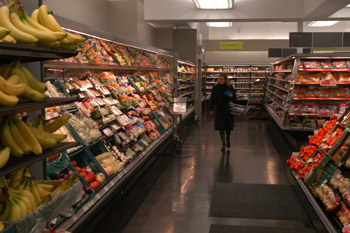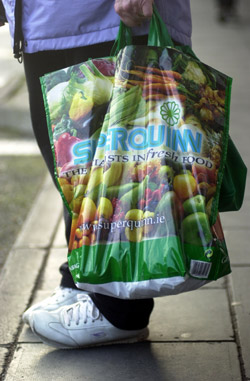Half-time

The first half of Recession 2009 is over and, so far, it has lived up to expectations. The good news for round two however, is at least now we know what to expect.
11 June 2009
At the start of this year, we came into an environment so completely different from the one we entered at the start of 2008 many would not have believed it possible.
Food and commodities inflation was continuing it’s downward trend, hitting 1.1% by year end; a staggering 8.2% difference versus the high of 9.3% recorded in March ‘08. Food prices continued to fall as the global commodities markets contracted and economic activity around the world slowed to a halt.
By the end of 2008, food sales in Ireland were down 3% compared with the previous year, reflecting the decline in consumer spending across the entire economy. Ireland braced itself for the unknown pain ahead.
In February the Central Statistics Office (CSO) released figures revealing that retail sales in Ireland had hit a 25-year low, with sales volumes down 8.1% in the year, and down 6.8% by value. The sharp fall in inflation however was not reflected in the prices of all goods, as tobacco and alcoholic beverages rose 6.8% in the same period, and food and non-alcoholic drinks increased 3.2%.
By March, new CSO stats gave rise to concerns that we now faced a real threat of deflation “becoming embedded” in our economy, as the rate of inflation fell again to -0.1%. Property values were plummeting, prices across all sectors were dropping, but still businesses called out to Government that costs we’re not coming down fast enough to respond to the crisis.
Historic lows
In late March the CSO announced that Ireland had experienced its greatest ever fall in economic activity, a quarterly of drop in GDP of 7.5% in the last three months of ’08, the biggest on record. Consumer spending was down 4%, food sales were down 3%, and the rate of unemployment was on the rise, hitting 11% by March and growing by an average of 0.5% each month for the first four months; unemployment stood at just over 5% the previous March.
Consumer prices fell 2.6% in the year to March to reach levels not seen in Ireland since the 1930s. The annual rate of inflation fell again to -2.6%, depths only comparable with the economic outlook in 1933.
The only relief in the midst of the ongoing turmoil and uncertainty came when the ECB began cutting interest rates, allowing mortgage repayments to drop (-13.8% between March and April). However, this did not translate into rent reductions for the majority of businesses and those who could not renegotiate terms, and those for whom a change of premises was not possible in particular, were at a grave competitive disadvantage. Further adding to their difficulties, local authority rates and energy costs were not coming down, and the Government actually put up the costs for businesses in its emergency budget through an insurance levy and by increasing the tax on diesel.
Against this backdrop the grocery sector struggled to drop prices and remain equitable. In addition to the economic and financial challenges facing all businesses, Irish retailers were also faced with the problem of Northern Ireland, where VAT decreased 2.5% to 15% while ours increased to 21.5% at the same time. And with sterling so weak against the euro as to afford Irish shoppers savings of up to 40%, the situation has worsened for retailers in the Republic as the recession has deepened, and become untenable for retailers in border towns.

Superquinn was “left with no alternative” but to close its Dundalk outlet, the first ever store opened by Feargal Quinn in 1960

Superquinn was “left with no alternative” but to close its Dundalk outlet, the first ever store opened by Feargal Quinn in 1960
The cost of cross-border shopping
Cross-border shopping last year is estimated to have cost us €550 million in sales and €90 million in lost VAT revenue. Moreover, alcohol sales constituted a significant proportion of this figure, leading to the announcement this year by Drinks Industry Group Ireland of the worst alcoholic drinks performance in 25 years. Based on current trends, DIGI estimates that cross-border alcohol purchases alone will represent a tax revenue loss of E100 million to the Irish economy in 2009.
Figures released by the Stormont Department of Enterprise, Trade and Investment said that the number of Republic of Ireland residents visiting Northern Ireland has increased by 14% and that the spend per visit is also increasing; by 13.5% on average. Subsequent to this exodus of Irish shoppers, Asda and Sainsbury now hold a 2.5% share of the Irish grocery market, without having a single outlet here.
The cost to the Irish grocery trade has been heavy and far-reaching. In January Superquinn announced that it was “left with no alternative” but to close its doors in the border town of Dundalk, the first ever store opened by Feargal Quinn in 1960. The company also announced it was reducing its 3,300 strong workforce by cutting approximately 400 jobs in order to regain competitiveness.
The following month Dunnes Stores also closed its Park Street outlet in Dundalk, after 30 years trading in the town. Reports soon emerged in the press that the company was seeking 60 voluntary redundancies from among its 200 management staff, with plans to cut staff working hours by up to 10% in all 130 of its stores around the country. Dunnes also closed its clothing and home-ware outlets on Dublin’s Grafton Street and George’s Street respectively.
Meanwhile, Dundalk and many other border towns saw retail units abandoned and boarded up, as businesses failed to cover their costs to continue trading. Across the entire country, footfall fell by 8% year-on-year, compared with a 7% increase in Northern Ireland for the same period (Experiean FootFall). Consequently the retail sector became one of the worst effected by job losses; Retail Excellence Ireland estimated the total would reach 40,000 by the end of the first quarter of 2009 alone.
Game of two halves
Consumer habits have changed dramatically in the last six months, and most likely for good. What was once a population of ‘cash-rich, time-poor’ shoppers that didn’t count their change or check their receipts has been replaced by a much more price-conscience group; and for the time being a group that is fearful for the future.
The strongest indicator of Irish consumers’ changing attitudes and behaviour has been the unprecedented rise of the discounters Aldi and Lidl, which achieved combined market growth of 40% in the year to January 2009, according to Nielsen. Spurred on by its impressive performance here, Aldi Ireland announced a €350 million expansion plan that included opening 35 new stores, 14 of which are due to open this year. By May, like-for-like sales in Aldi’s Irish stores had increased by 23%.
On the other hand, as we see in the pages of this magazine every month, numerous independent retailers around the country have been able to adapt their businesses to meet current needs and demographic changes, with some even recording positive growth. The major learning from this is that, not only is it possible to re-structure and remain viable, but Irish consumers still maintain that unique relationship with their local shops.
At over 18% penetration, the convenience sector in Ireland is proportionally three times larger than the nearest European equivalent. It is probable that this figure is unsustainable and there will be more bloodshed before the year is out. However, those retailers with the talent and desire to succeed now almost certainly will, and Irish consumers will continue to need their services.
Furthermore, latest figures from the CSO show that the rate of unemployment has started to slow down. While this still leaves record numbers on the live register, at least confidence will start to return by degree among those who have hung on to their jobs.
Another boost to Irish retailers in the next half lies in the fact that the state of play between the North and Republic of Ireland is beginning to change. As we went to print, sterling had fallen back to 87p to the euro, a significant difference compared with the near par values at Christmas time. Furthermore, the return of British VAT to 17.5%, which is due to happen in January 2010, may happen even earlier, as the move has been widely deemed a costly mistake for the UK coffers.
Stability will return to certain global markets by the end of this year and we will see, at last, the end of the global recession. Ireland faces more challenges before our own economy will correct itself but in the meantime we can take solace from the fact that the freefall is over, and so is the worst of the uncertainty.
Top 10 stories of First Half 2009
1 Tidal wave of crime
According to the Garda Síochána, decreased revenues for drug gangs during the downturn has lead to an increase in violent crime. And with most retailers now keeping an ATM on their premises, they are increasingly the targets of ram-raids and tiger kidnappings, which was the subject of the headlines more than once this year.
According to CSO crime statistics, robbery and hijacking increased 5.5% in the 12 months to the end of last September; a total of 2,350 cases in the year. Banks advise retailers not to leave any cash in their ATM machines overnight.
2 Retailers ban the Sindo
Things came to a head between retailers and Independent Newspapers in March. Following an increase in wholesale prices, and increases in its subsidiary, Newspread’s delivery charges, retailers took collective action and banned the Sunday Independent from their shelves over several successive Sundays.
In early March however, two weeks after retailers in the capital joined the fray, the Independent group called for talks to stop the action. By this time retailers all over the country had engaged in weeks of collective action on a daily basis, organised via text message, with Galway carrying on an all-out ban on the Sunday Independent for seven weeks.
3 The NCA: a survey too far?
In February, the National Consumer Agency released another of its biannual price surveys, this time showing that competition between the multiples was increasing. The gap in the branded market was widening, while the private label market was closing in. ‘Ireland’s biggest discounter’ Tesco was found to be the dearer than Superquinn, while Supervalu – which the NCA once praised for being able to compete with the multiples – was named the dearest of them all. Confused? We all were. So were its own it seems, as board member Eddie Hobbs jumped ship in May, stating that he didn’t believe the NCA boards’ fees represented ‘good value’ for taxpayers money!
4 Oireachtas orders supply chain investigation
The televised Oireachtas committee meeting with Ireland’s major retailers appeared to be the start of a major investigation which would answer Ireland’s price conundrum. As we know now though it has resulted in no such thing.
Big names such as John Foy, retailer and chairman of RGDATA, Tony Keohane, CEO Tesco Ireland, and Aldi Ireland chief Donald Mackay, all stepped up to reveal that goods could be bought more cheaply outside the State, and that Irish suppliers should be questioned about their prices. Food and Drink Industry Ireland’s Paul Kelly said however, that the top three chains in Ireland control 70% of the channel and suppliers are squeezed to meet retailers’ demands.
The Tánaiste responded by commissioning another report from the Competition Authority (yes, additional to the Grocery Monitor it just spent three years compiling), and as of going to press, the Department had no word on when we might expect it.
5 Irish drinks trade hit hardest in 25 years
The alcoholic drinks trade came up one of the biggest casualties of the downturn this year. Drinks Industry Group Ireland revealed the Irish alcoholic beverage sector experienced its worst performance in a quarter of century, thanks to declining alcohol consumption and, most especially, cross-border shopping. Volume sales in 2008 declined 5.9%, over twice the rate of decline in 2007. DIGI forecasts that 2009 will unfortunately see even worse news for the sector, with an estimated 10% of trade migrating over the border to avail of the lower tax and advantageous exchange rates; a loss of over €100 million in tax revenue for Ireland.
Chairman of the National Off-Licence Association Jim McCabe has said that the loss to local economy in terms of employment from off-licences has amounted to the equivalent of at least 2,250 jobs nationwide. And DIGI predicts as much 9,000 jobs could be lost across the sector this year.
6 Pork industry rocked by dioxin scandal
The fact that the Government’s agriculture committee found the recall of Irish pork products was unnecessary in 90% of cases is little comfort now to affected businesses. According to its report, the contamination, which originated at Millstream food recycling plant, was not identified due to failures in the Irish inter-agency food safety system. As a consequence of inadequacies in Ireland’s traceability checks, the country’s entire pork industry output had to be recalled last December, despite contamination of only a possible 10%. The scandal is said to have cost the pig meat sector an estimated €100 million, but so far only 50% of the Government’s compensation package has been paid out, according to the Irish Farmers Association.
7 Retail sector wages go up
Despite over 600 letters from retailers representing themselves and their employees, the Joint Labour Committee refused to hear submissions to have the first of two 2.5% wage increases for the retail sector deferred. As 24 April came around, the retail sector was forced to cope with an increase in labour costs, during the worst recession seen by the country in over 80 years.
Tara Buckley, director general RGDATA said there was “no political appetite” at this point to intervene and address the situation facing businesses and employees in the sector. RGDATA, Ibec and the CSNA continue talks with JLC to attempt to defer the additional 2.5% increase due on 24 October.
8 ‘Swine flu’ strikes the pig industry
The virus A/H1N1, incorrectly dubbed ‘swine flu’ the world over, has been the unfortunate cause of massive trade losses, falling share prices, and the culling of 10s of 1,000s of perfectly healthy pigs. In spite of countless statements issued from global and national food safety and health organisations clarifying that the virus has not been isolated in a single animal, several countries nonetheless took the opportunity to impose import bans on countries with confirmed (human) cases. Before a single person had contracted the virus in this country, both Safefood and the FSAI had released statements assuring the safety of Irish pork. Cormac Healy, director Meat Industry Ireland, commented that it is “regrettable” that such media hype could lead to “seriously undermining the sector.”
 9 Controversy thy name is Tesco Ireland
9 Controversy thy name is Tesco Ireland
On 5 May Tesco Ireland grabbed the nation’s attention with the launch of its ‘Change for good’ campaign, reopening the 11 border stores it closed before the bank holiday weekend to reveal its new price/supply structure. Proudly it announced an average 22% price reduction over 12,500 lines, using the buying clout of Tesco UK while remaining ‘committed’ to supplying Irish brands and products. Strangely, there have been non-stop reports of Irish brands’ presence in Tesco outlets becoming increasingly tiny ever since.
In the midst of accusations of using Irish suppliers as “cannon fodder” in a supermarket price war, Tesco Ireland hit the headlines again when a supposed leaked document to The Irish Times allegedly revealed the retailer was creaming over 9% margin out of the Irish market. We have to hand it to them, they grabbed more headlines than Jordan!
10 Dark tobacco, the final countdown
As we went to press, the Office of Tobacco Control and the Department of Health and Children held a meeting with representatives of the retail, hospitality, and tobacco trade. A chance to explain the rules and, so to speak, clear the air before the fun and games begin on 1 July. In theory, the rules are plain and there should be no confusion; and retailers should apply to get on the tobacco register as early as possible. In reality however, everyone will have to wait and see what each Environmental Health Officer decides does and does not count as indecent exposure (of tobacco products that is).



 Print
Print






Fans 0
Followers